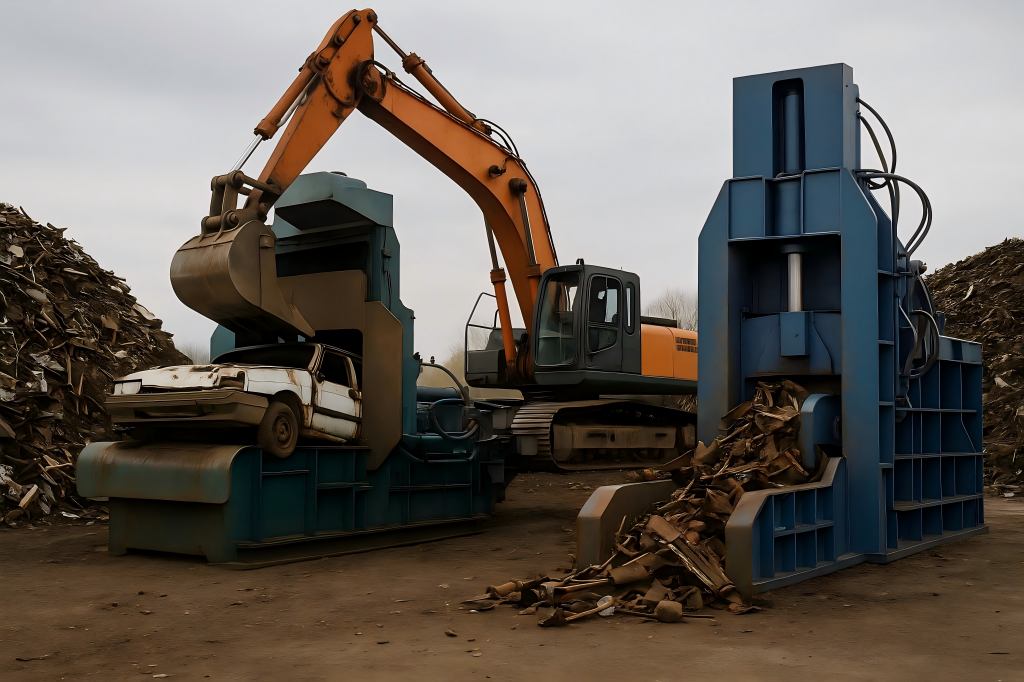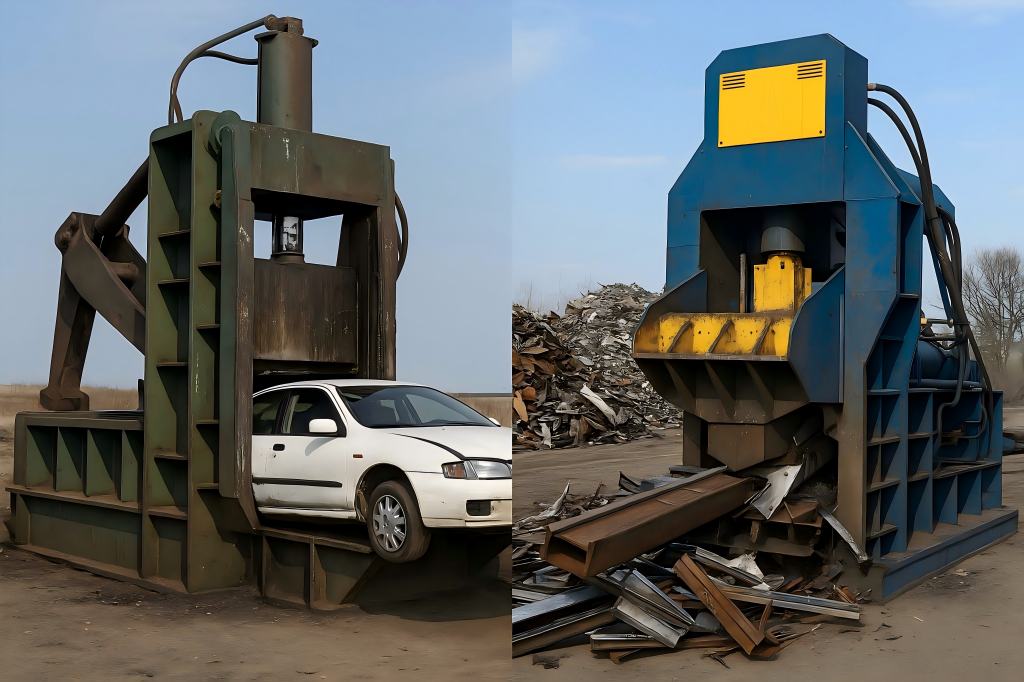As vehicle recycling becomes more important for the environment and the circular economy, choosing the right equipment is key. Car balers and shear balers are the main machines used, each with different functions and best uses.
This article compares them to help you decide which is better for your recycling needs.
What Is a Car Baler?
A car baler, also called a vehicle baler or scrap car baler, is a machine designed to compress complete or partially dismantled vehicles into compact, high-density bales. The objective is to reduce the volume of scrap vehicles for easier transportation, storage, and further processing (such as shredding or smelting).
Key features:
- Hydraulic compression from multiple sides (top, side, and end)
- Manual, semi-automatic, or fully automatic control
- Optional crane or grab for car loading
- Compact design for yard or mobile use
What Is a Shear Baler?
A shear baler combines the capabilities of shearing and baling. It can cut vehicles into smaller pieces using a powerful guillotine-like shear before compressing and ejecting them. This makes it possible to size material before further downstream processing.
Key features:
- High-capacity hydraulic shear blades
- Pre-compression box or wings to hold scrap during cutting
- Programmable cycle for cutting, baling, and ejecting
- Suitable for mixed or complex scrap
Working Principle Comparison
| Feature | Car Baler | Shear Baler |
| Operation | Compresses vehicles into bales | Shears scrap into pieces + baling |
| Compression Type | Multi-sided hydraulic press | Pre-compression + hydraulic shear |
| Output | Dense rectangular bales | Cut scrap sections or compact blocks |
| Ideal Input | Whole or semi-dismantled vehicles | Heavy or mixed scrap, ELVs, long steel |
| Cycle Time | 2–5 minutes per bale | 3–8 minutes per shear cycle |
Material Handling Capabilities
Car balers are most effective for:
- Light to medium vehicles
- Dismantled cars
- Aluminum and thin steel frames
- Pre-sorted, clean ELVs
Shear balers are more versatile and can handle:
- Heavily damaged or complete vehicles
- Mixed scrap (pipes, beams, white goods)
- Engines and drivetrain components
- Reinforced steel and construction waste
If you’re handling mainly whole vehicles or running a dedicated car recycling operation, a car baler is sufficient. For mixed metal yards or high-volume, diverse scrap streams, a shear baler offers more flexibility.
Output and Downstream Compatibility
Car Baler Output:
- Standard bales sized for transport containers
- Ideal for shipment to shredders or mills
- Often requires additional shredding or cutting
Shear Baler Output:
- Smaller scrap sizes, ready for furnace or direct resale
- Eliminates the need for secondary shredding in many cases
- Improved pricing due to size and cleanliness
Sheared materials are often preferred by steel mills and foundries due to easier handling and melting consistency.
Efficiency and Processing Speed
Car Baler Pros:
- Faster cycle time for baling
- Lower power consumption
- Higher throughput for clean, sorted ELVs
Shear Baler Pros:
- Handles more types of scrap per cycle
- Eliminates the need for upstream processing (e.g., dismantling)
- Fewer logistical steps post-shearing
The efficiency ultimately depends on your scrap input type. For yards receiving large volumes of sorted ELVs, a car baler delivers better cycle efficiency. For unsorted or heavy scrap, shear balers are more productive over time.
Cost Considerations
| Factor | Car Baler | Shear Baler |
| Initial Purchase Cost | $100,000 – $250,000 | $300,000 – $800,000+ |
| Installation Requirements | Minimal (mobile or stationary) | Extensive (usually stationary) |
| Energy Consumption | Lower | Higher |
| Operating & Maintenance Costs | Moderate | High (due to wear on shear blades) |
| Return on Investment (ROI) | Fast in car-only operations | Higher ROI for large mixed yards |
Shear balers have a steeper price curve but may yield better returns over time in larger or more complex operations. Car balers have a quicker break-even point for small to medium scrap yards.

Portability and Space Requirements
Car balers are available in mobile variants mounted on trailers, making them ideal for:
- On-site ELV processing at junkyards or auctions
- Mobile car crushing services
- Rural or decentralized recycling locations
Shear balers are typically large and stationary due to their high shear force and heavy-duty construction. They require:
- Foundation and infrastructure setup
- Dedicated operator station
- Significant yard space and safety clearance
If mobility and flexibility are critical, car balers have a clear advantage.
Safety and Automation
Improved safety features seen on contemporary balers and shears include:
- Emergency stop buttons
- Hydraulic interlocks
- Operator protection cages
- PLC-based automation
Car Balers:
- Easier to operate
- Safer for new operators
- Lower risk of flying debris or blade failure
Shear Balers:
- Require skilled operators
- Higher mechanical stress
- Risk of misfeeding or shear blockages
Advanced shear balers include safety zones and auto-feeding systems, but they still require rigorous training and safety protocols.
Maintenance Requirements
Car Baler Maintenance:
- Routine hydraulic checks
- Cylinder and seal replacement
- Lubrication and alignment
Shear Baler Maintenance:
- Frequent blade sharpening or replacement
- More hydraulic wear-and-tear
- Regular checking of cutting forces and cycles
Because of the wear-heavy nature of shearing, shear balers need more downtime and maintenance labor. Car balers tend to have simpler service routines and parts.
Environmental and Regulatory Considerations
Both machines contribute to environmental sustainability by enabling efficient metal recycling. But there are some distinctions:
Car Balers:
- Require proper fluid draining and depollution before use
- Produce less noise and vibration
- Lower emissions if mobile units are used
Shear Balers:
- May process non-depolluted ELVs (if regulations allow)
- Produce more noise and heat
- Require dust and spark suppression systems
For compliance with end-of-life vehicle recycling regulations (such as the EU ELV Directive or U.S. EPA standards), car balers may align better with fluid-free processing models.
When to Choose a Car Baler
A car baler is ideal if:
- You primarily handle depolluted ELVs
- You need to reduce transport costs by compacting
- You operate in smaller yards or offer mobile services
- You prioritize lower cost and faster ROI
- You aim to supply feedstock to shredders
Example users:
- Small to mid-sized scrap yards
- Mobile crushing businesses
- Vehicle dismantlers and auction processors
When to Choose a Shear Baler
A shear baler is better suited if:
- You process a variety of scrap, including cars, beams, engines, and white goods
- You want to eliminate downstream shredding
- You need output ready for smelting or resale
- You have the infrastructure and skilled labor
- You operate at high volumes
Example users:
- Large-scale recycling yards
- Foundry preparation centers
- Mixed-metal processors
Case Study Comparison
| Criteria | Medium Yard with ELVs Only | Large Urban Scrap Processor |
| Input Type | Depolluted cars | Mixed scrap, ELVs, structural |
| Volume | 50–100 vehicles/day | 100+ tons of mixed metal/day |
| Space Available | 2000 m² | 10,000 m²+ |
| Labor Skill Level | Basic hydraulic machine handling | Skilled shear operators, PLC tech |
| Preferred Machine | Car Baler | Shear Baler |
This comparison demonstrates that the right choice depends heavily on your input material, yard capacity, budget, and output goals.




